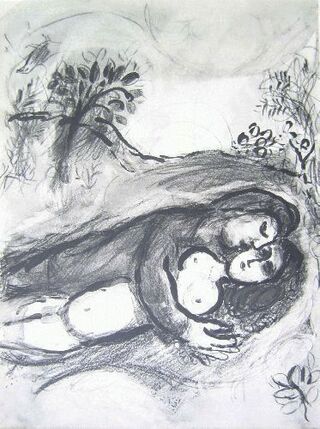Genetics
Gene Flow in History
We are the bearers of our history of reproductive competition.
Posted December 3, 2021 Reviewed by Ekua Hagan
Key points
- Studies of both DNA and aDNA have uncovered evidence of reproductive bias linked to known historical events.
- Historical invaders of other populations are better represented in human gene pools than the displaced.
- The male contribution to Native American DNA is close to 90%.
- African-American ancestry is on average 73% African and 24% European.

The first war in the Torah starts 34 chapters into Genesis. Dinah, the daughter of Jacob, has attracted the interest of Shechem, the son of Hamor. He fell in love with her. “His soul was drawn to Dinah the daughter of Jacob; he loved the maiden and spoke tenderly to her.”
But then, he raped her. “He seized her and lay with her and humbled her.” So Shechem and Hamor had themselves circumcised, as the sons of Jacob had asked. Havoc ensued. “On the third day, when they were sore, two of the sons of Jacob, Simeon, and Levi, Dinah’s brothers, took their swords and came upon the city unawares, and killed all the males.” Their city was plundered and their herds were led away. And their women were carried off: “All their little ones and their wives” (Genesis 34:1-29).
Who would believe that sort of drivel?
Probably Walter Scheidel. Dickason professor in the humanities, professor of classics and history at Stanford University, a past Moses and Mary Finley Research Fellow in ancient history at Darwin College in the University of Cambridge, and a previous lecturer in ancient history in the department of ancient history at the University of Vienna, Scheidel is at the nexus of historical scholarship.
He’s edited the Oxford World History of Empire, State and Power in Ancient China and Rome, the Oxford Handbook of the State in the Ancient Near East and Mediterranean, the Cambridge Companion to the Roman Economy, The Oxford Handbook of Roman Studies, the Dynamics of Ancient Empires, the Cambridge Economic History of the Greco-Roman World, The Ancient Economy, and Debating Roman Demography.
And he’s written two books on the rise and fall of Mediterranean empires. The first, The Great Leveler: Violence and the History of Inequality from the Stone Age to the Twenty-First Century, was published in 2017; the second, Escape from Rome: The Failure of Empire and the Road to Prosperity, came out in 2019. Scheidel doesn’t take scriptural evidence lightly.
He does consider supporting evidence. Especially genetic evidence.
Examining genetic data in light of historical invasions
Over the last couple of decades, a growing number of studies of both DNA, taken from contemporary human groups, and aDNA, genetic data derived from human remains, have uncovered evidence of reproductive bias linked to known historical events. Migrations. Enslavements. Conquests. Across history, and across prehistory, when men have invaded a territory, they’ve pillaged and they’ve raped. Invaders are well-represented in H sapiens gene pools. The displaced, not so much.
Not long after the start of the Holocene, at the end of the last Ice Age and the onset of agriculture, there is evidence of a genetic bottleneck: Far fewer males than females were able to pass their DNA on. That ratio was as high as 1:17. Civilization discontented them.
Populations associated with the Yamnaya, a steppe culture from the around Black and Caspian Seas, swept through Europe, Siberia, and South Asia after around 3000 BCE. Indo-European languages accompanied their aDNA. Steppe lineages replaced as much as 90% of earlier male ancestry as far away as Britain by around the third millennium BCE. And on the Iberian Peninsula, by the second millennium, almost all Y chromosomes had been replaced by invaders with Steppe ancestry. Other inflows from the Steppe left their mark on the Indus, after about 2000 BCE, where from 50% to 90% of Y-chromosomal ancestry is of West Eurasian origin, and reflects the immigration of early Indo-Europeans.
Scheidel asks a simple question: “How did this happen?” And offers a simple answer. “It would seem hard to come up with a narrative that does not to some extent involve the violent takeover of resources and mates: accounts of war-chariots and warrior-culture.” He refers readers to the Rig Veda.
Steppe takeovers are hardly the end of the story. Mongol invasions, under Genghis and his descendant Khans, are famously supposed to have spread Y-chromosome star-clusters to as many as 8% of all late-21st-century Central Asian men.
And in the New World, European Y-chromosomes took over. Genetic studies have indicated the scale differential reproductive success. The male contribution to American Mestizos ranges from 50% to 80%; for women, the figure is closer to 90% Native American DNA. And in the United States, African-American ancestry is on average 73% African but 24% European.
From one end of Asia to the other end of the Americas, from top to bottom of the globe, we are the bearers of our history of reproductive competition. Not an easy precedent to put an end to. But a precedent we have to be aware of, if we ever intend to try.
References
Scheidel, Walter. 2022. Fitness and Power, in L. Betzig, guest editor, "Evolution & History," in Evolutionary Psychology, in press.


